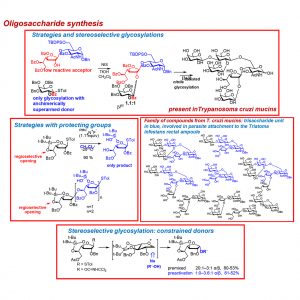Síntesis de oligosacáridos de microorganismos patógenos. Estrategias y glicosidaciones selectivas.
Integrantes:
Dra. Carola Gallo-Rodriguez – Investigadora Independiente CONICET - Profesora Asociada (DE) DQO, FCEyN, UBA
Dra. Tamila P. Galaka – Beca postdoctoral CONICET – Ayudante de 1ra, DQO, FCEN, UBA.
Lic. Carmen Rosa Cori Calizaya – Beca doctoral CONICET – Ayudante de 1ra, DQO, FCEN, UBA.
Lautaro Altaleff – Becario estímulo UBA 200 años – Ayudante de 2da, DQO, FCEN, UBA.
Resumen
Los carbohidratos complejos se encuentran involucrados en una amplia variedad de procesos biológicos. Como consecuencia, el campo de la glicobiología y la glicociencia está creciendo rápidamente. Sin embargo, el obstáculo más importante para este desarrollo es la baja disponibilidad de oligosacáridos puros y bien definidos que no contengan microheterogeneidades, difíciles de obtener de fuente natural. A diferencia de otros biopolímeros, las células producen carbohidratos como mezclas heterogéneas. Por ese motivo, en los últimos años, ha habido un resurgimiento en el estudio de la síntesis de oligosacáridos. Ésta se caracteriza por su complejidad pues involucra la construcción de uniones glicosídicas regio- y estereoselectivas partiendo de donores y aceptores que deben ser cuidadosamente elegidos dado que influyen considerablemente en el transcurso estereoquímico de las reacciones de glicosidación. A pesar los avances realizados en las últimas décadas, muchos problemas quedan aún sin resolver, sobre todo cuando el desarrollo de esta temática se ha focalizado en derivados piranósicos mientras que sobre furanosas, estos estudios son mucho más limitados. Nuestro interés se encuentra centrado en desarrollar métodos de síntesis efectivos para la obtención de oligosacáridos, precisando las dificultades del área. Dentro de los mismos, aquellos que contienen galactofuranosa son de gran interés dado que esta unidad es común en microorganismos patógenos, no así en mamiferos donde la galactosa se encuentra en su forma piranósica. Por esa razón, se considera el metabolismo de la galactofuranosa como un blanco potencial de quimioterapia. El objetivo general del proyecto se enmarca en el desarrollo de glicosidaciones estereoselectivas y estrategias sintéticas novedosas para la síntesis de oligosacáridos y dentro del mismo hemos considerado objetivos sintéticos constituyentes de microorganismos patógenos como Trypanosoma cruzi, entre otros. Estos mismos podrían ser utilizados para el desarrollo de neoglicocongujados por condensación de los oligosacáridos sintetizados con proteínas para su evaluación como vacunas, para el estudio de la biosíntesis, así como para la elucidación de sus roles biológicos.
Abstract
Complex carbohydrates are involved in a wide variety of biological processes. Therefore, the field of glycobiology and glycoscience have been rapidly growing and received much attention. However, the main obstacle for this development is the low availability of pure and well-defined oligosaccharides containing no microheterogeneities which are difficult to obtain from natural sources. Unlike other biopolymers, cells produce carbohydrates as heterogeneous mixtures. For this reason, the study of the synthesis of oligosaccharides has reemerged in recent years. It is characterized by its complexity as it involves the construction of regio- and stereoselective glycosidic linkages. Donors and acceptors must be carefully chosen since they considerably influence the stereochemical course of the glycosylation reaction. Despite the progress addressed in the last two decades, many issues are still unsolved. The development of this subject has been focused on pyranose derivatives while studies are much more limited on furanoses. Our interest is centered on developing synthetic methods for obtaining oligosaccharides addressing the difficulties of the area. Galactofuranose-containing oligosaccharides are of great interest because Galf unit is commonly found in pathogens but not in mammals with the galactose solely in the pyranose form. For that reason, the galactofuranose metabolism is considered as a potential target for chemotherapy. The aim of the group is the development of stereoselective glycosylation reaction and novel synthetic strategies for the synthesis of oligosaccharides and within the same goals we have considered synthetic constituents of pathogenic microorganisms such as Trypanosoma cruzi, and others. These targets could be used for the development of neoglycoconjugates by condensation of the oligosaccharides with proteins for evaluation as vaccines, for the study of its biosynthesis, as well as for the elucidation of their biological roles.
Publicaciones seleccionadas / Selected publications
Synthesis of the hexasaccharide from Trypanosoma cruzi mucins with the Galp(1→2)Galf unit constructed with a superarmed thiogalactopyranosyl donor. G. A. Kashiwagi, C. R. Cori, R. M. de Lederkremer, C. Gallo-Rodriguez*. Carbohydrate Research 482, 107734 (2019). https://doi.org/10.1016/j.carres.2019.06.013
Trypanosoma cruzi surface mucins are involved in the attachment to the Triatoma infestans rectal ampoule. M. M. Cámara, V. Balouz, C. Centeno Cameán, C. R. Cori, G. A. Kashiwagi, S. A. Gil, N. P. Macchiaverna, M. V. Cardinal, F. Guaimas, M. Lobo, R. M. de Lederkremer, C. Gallo-Rodríguez, C. A. Buscaglia. PLOS Neglected Tropical Diseases, 13, e0007418, (2019). https://doi.org/10.1371/journal.pntd.0007418
The role of the phosphorus atom in drug design. J B. Rodriguez* and Carola Gallo-Rodriguez. ChemMedChem, 14, 190 – 216 (2019).
Regioselective opening of 3,5-O-di-tert-butylsilylene-D-galactofuranosides. Synthesis of (1→5)-β-D-galactofuranosyl derivatives. M. J. Tilve, C. R. Cori, C. Gallo-Rodriguez*. J. Org. Chem. 81, 9585 −9594 (2016).
Synthesis of the O-linked hexasaccharide containing β-D-Galp-(1→2)-D-Galf in Trypanosoma cruzi mucins. Differences on sialylation by trans-sialidase of the two constituent hexasaccharides. R Agustí, M. E. Giorgi, V. M. Mendoza, G. A. Kashiwagi, R. M. de Lederkremer* and Carola Gallo-Rodriguez*. Bioorg. Med Chem., 23, 1213–1222 (2015).
Conformationally restricted 3,5-O-(di-tert-butylsilylene)-D-galactofuranosyl thioglycoside donor for a-galactofuranosylation. M. J. Tilve, C. Gallo-Rodriguez*. Carbohydr. Res. 397, 7-17 (2014).
Synthesis of α-D-Glcp-(1→3)-α-D-Galf-(1→2)-α-L-Rhap constituent of the CPS of Streptococcus pneumoniae 22F. Effect of 3-O-substitution in 1,2-cis α-D-galactofuranosylation. G. Gola, C. Gallo-Rodriguez*. RSC Adv. 4, 3368 – 3382 (2014).
Synthesis of the O-linked hexasaccharide containing β-D-Galf-(1→2)-β-D-Galf in Trypanosoma cruzi mucins. G. A. Kashiwagi, V. M. Mendoza, R. M. de Lederkremer, C. Gallo-Rodriguez*. Org. Biomol. Chem. 10, 6322–6332 (2012).